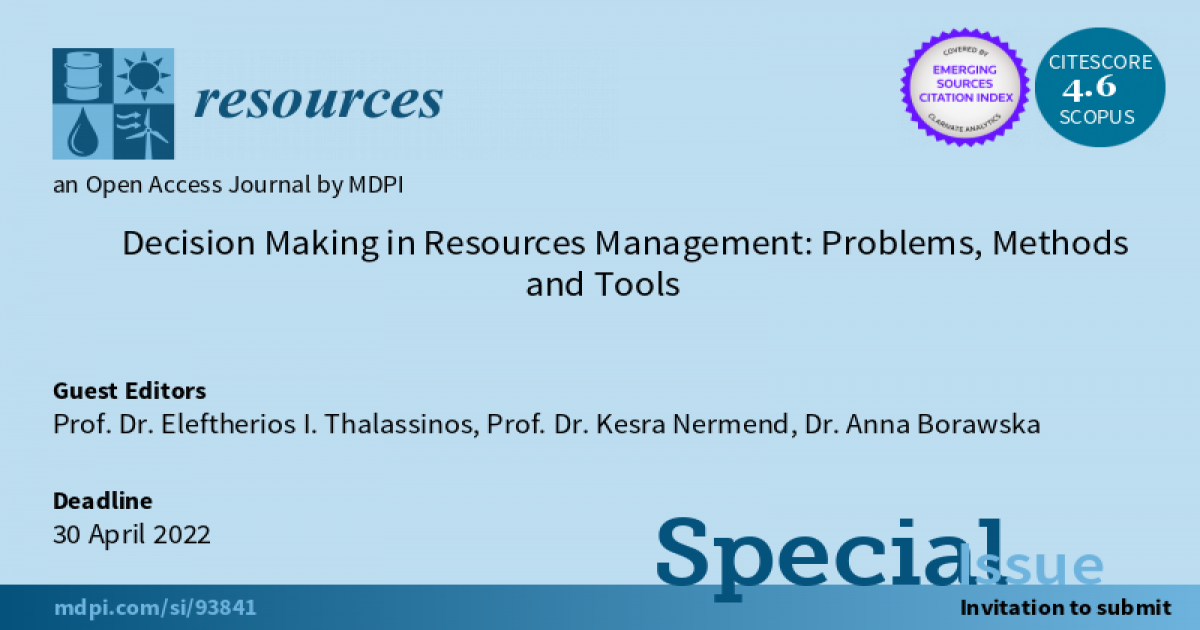Decision Making in Resources Management: Problems, Methods and Tools
A special issue of Resources (ISSN 2079-9276).
Deadline for manuscript submissions: closed (30 March 2023) | Viewed by 34488

Special Issue Editors
2. Faculty of Economics, Management and Accountancy, University of Malta, 2080 Msida, Malta
Interests: sustainability; risk management; finance and financial institutions; business models
Special Issues, Collections and Topics in MDPI journals
Interests: Issues related to the use of quantitative methods and IT tools in decision support, with particular emphasis on: multi-criteria methods, multi-dimensional data analysis, cognitive neuroscience techniques in the study of social behavior and modeling consumer preferences in the process of making business decisions
Special Issues, Collections and Topics in MDPI journals
Interests: conducting scientific experiments in the study of economic processes and social preferences using methods of microsimulation, macrosimulation, artificial intelligence, multidimensional comparative analysis and methods of cognitive neuroscience
Special Issue Information
Dear Colleagues,
The Special Issue entitled “Decision Making in Resources Management: Problems, Methods and Tools”, dedicated to the 17th edition of ICABE conference, focuses on the broad topic of decision-making concerning resources management in various aspects—theoretical, methodological, practical, ecological, and legal.
Resource management involves allocating resources according to the needs, aspirations, and desires of people within the framework of society’s technological inventiveness, political and social institutions, and legal and administrative arrangements regarding broad living and the working environment. This process is a conscious procedure, involving judgment, preference, commitment, and sustainability, whereby desired outputs are sought from a limited set of perceived resource combinations through various managerial, technical, and administrative alternatives. Such resources may include financial resources, inventories, human skills, production resources, information technology (IT), managerial capabilities, and natural resources. Therefore, resource management decisions are part of a complex, multi-faceted process offering wide possibilities for scientific investigation, challenges, and innovations.
We invite everyone interested in the above subjects to submit high-quality research articles covering the wide range of topics, as described above, related to theoretical aspects of decision-making in resource management and practical problems that arise at various levels (case studies).
Topics of interest for this Special Issue are connected with the use in supporting the process of decision making in resource management and data acquisition for decision making purposes, including (but not be restricted to) such methods and tools as multi-criteria decision analysis (MCDA), operational research methods, multidimensional comparative analysis (MCA), modeling and computer simulation, artificial intelligence, econometric and statistical methods, neuroscience techniques, focus group interview (FGI), individual in-depth interviews (IDI), data text mining, IT tools, decision support systems, computer games, virtual reality, and other methods and tools.
Prof. Dr. Eleftherios I. Thalassinos
Prof. Dr. Kesra Nermend
Dr. Anna Borawska
Guest Editors
Manuscript Submission Information
Manuscripts should be submitted online at www.mdpi.com by registering and logging in to this website. Once you are registered, click here to go to the submission form. Manuscripts can be submitted until the deadline. All submissions that pass pre-check are peer-reviewed. Accepted papers will be published continuously in the journal (as soon as accepted) and will be listed together on the special issue website. Research articles, review articles as well as short communications are invited. For planned papers, a title and short abstract (about 100 words) can be sent to the Editorial Office for announcement on this website.
Submitted manuscripts should not have been published previously, nor be under consideration for publication elsewhere (except conference proceedings papers). All manuscripts are thoroughly refereed through a single-blind peer-review process. A guide for authors and other relevant information for submission of manuscripts is available on the Instructions for Authors page. Resources is an international peer-reviewed open access monthly journal published by MDPI.
Please visit the Instructions for Authors page before submitting a manuscript. The Article Processing Charge (APC) for publication in this open access journal is 1600 CHF (Swiss Francs). Submitted papers should be well formatted and use good English. Authors may use MDPI's English editing service prior to publication or during author revisions.
Keywords
- methods of supporting decision making in the scope of resource management
- data acquisition for resource management decision-making purposes
- legal environment for decision making in resource management
- ecological and social aspects of decision making in resource management
- decision making in resource supply chains
- cost accounting in decision making in the context of resource management
- energy resources
- resource management in enterprises
Benefits of Publishing in a Special Issue
- Ease of navigation: Grouping papers by topic helps scholars navigate broad scope journals more efficiently.
- Greater discoverability: Special Issues support the reach and impact of scientific research. Articles in Special Issues are more discoverable and cited more frequently.
- Expansion of research network: Special Issues facilitate connections among authors, fostering scientific collaborations.
- External promotion: Articles in Special Issues are often promoted through the journal's social media, increasing their visibility.
- e-Book format: Special Issues with more than 10 articles can be published as dedicated e-books, ensuring wide and rapid dissemination.
Further information on MDPI's Special Issue polices can be found here.







